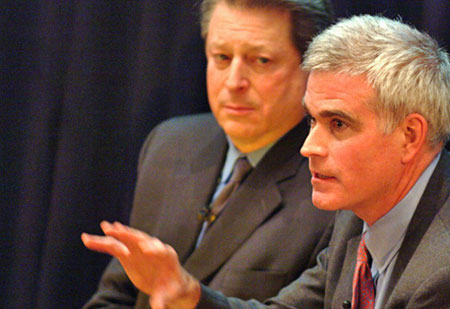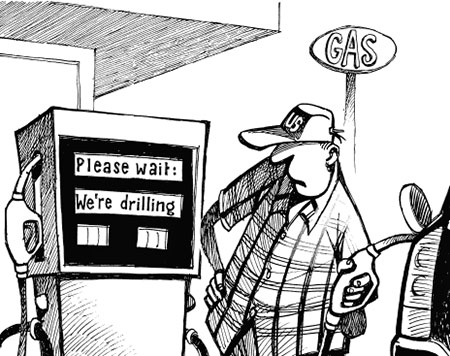|
by Andrew McKIllop
January 18, 2014
since Holland's 'Tulip Mania'.
It was great while it lasted,
but reality eventually caught up with the creative opportunists.
They created a market which has been disintegrating from day one, including a total collapse of the Chicago Climate Exchange, but not before the principle players cashed in their shares and abandoned that hip.
It's a epic story of
modern day high priests and sooth sayers, political hubris and
pseudo-scientific largess on a scale never before seen in history.
Get ready for the epic climb-down.
The carbon trading horror show.
Writing in 'Wall Street Journal' and similar outlets several times in 2013, they soldiered forward with the claim that "fossil carbon assets" are headed for a bust, and "green energy" can only soar.
Along with Britain's Lord Stern,
the former World Bank chief economist and author of the Stern Report
on "fighting"
global warming, they say all fossil fuels are so
dangerous for the world's climate they must be completely phased out
by 2050 or before.
The world's only mandatory credits trading scheme - in Europe - is struggling to keep itself afloat.
Reasons why Europe's ETS is now on political life
support and may be scrapped include massive over-issue of credits by
European governments and the European central authorities, outright
fraud and re-issue of already used credits, uncertainty concerning
the future value of credits, and other factors such as the intrinsic
worthlessness of 'hot air credits'.
Their twin fight against climate-damaging
and rapidly depleting oil, gas and coal reserves also has major real
world logic problems.
Which have heavily declined in most EU countries since 2008, except by supreme irony in Green Germany, presently constrained to rapidly increase its coal-fired power production.
European emissions have shrunk due to
economic recession, outplacement of energy-intensive industries,
energy saving, and the development of "green" non-fossil energy.
Today's credit prices are so low they
are no incentive to not emit CO2, making cheap credits a subsidy to
pollute and emit more CO2, while they also remain an incentive for
energy intensive industries to delocalize and quit Europe spurred by
fears that when ETS finally collapses, it will be replaced by
straight and high energy taxes.
Timewarp has rapidly affected the public and political perception of two basic key issues for policy and political change - peak oil and global warming.
What Stern, Gore and Blood regularly claim, that investing in "carbon assets" today is as crazy as speculating in subprime mortgages before 2008, now reads like schizoid black humor.
They say that after the 2008 credit crisis and Great Recession it is (with hindsight) ridiculous to have imagined that subprime mortgages could work.
The risk of giving around 7.5 million mortgages to people in the US who couldn't possibly pay them off was somehow "not on the radar screen" of most regulators and investors at the time.
Stern, Gore, Blood and other
carbon finance hopefuls still claim today that investing in fossil
energy is exactly the same thing.
At the other
end of the event horizon, if Detroit realty prices fall enough,
there will be sufficient empty homes to house millions! In both
cases the missing link which explains all is parasitic finance and
the tyranny of "investor expectations", meaning bang for the buck.
If car drivers feel OK with oil at $100 a barrel that is obviously their own problem, but their inability or refusal to switch fuels, to natural gas for example, does not reflect any planetary shortages of oil.
The outlook for serious oversupply of oil, today, is
credible but Goldman Sachs and the market maker banks operating oil
markets presently prefer not to see things that way.
At the time, the No Limits warmist stance was that CO² emissions - unless we completely stop them - will cause planetary disaster by sometime in the 2045-2099 period, so tailpipe or smokestack emissions must be taxed to extinction.
One absolutely real, and only
apparently contrarian, result would be a major fall of fossil energy
prices as Black Carbon became an illegal fuel, something like weight
watchers stacking shop windows with high-calorie foods they can't
eat - and can't be sold.
The argument by Gore, Blood and Stern goes on to claim investors have made a fundamental error by failing to understand there is not a calculable risk of global fossil fuel reserves becoming worthless - but an absolute certainty.
Investors have made a fundamental investing
error by only treating it as a risk and they will pay the
consequences as the industries they invested in collapse, possibly
in less than 10 years time.
They say that investors and political deciders confused risk
with uncertainty. According to hedge fund metrics, using "classical
analysis" risk can be priced, but uncertainty cannot.
His argument was "pure warmist" -
global temperatures will radically grow.
Because they must never be used - due to warming of 2°C being
probable by or before 2045 or 2050 - the IEA says.
This logic gap or chasm has opened up in only a few short years, from about 2005-2007 to today.
In 2005, things were totally different for the warmists.
That year, the UK's then-Labor government organized the "Avoiding Dangerous Climate Change" conference at the later-infamous Hadley Climate Research Center (home of the Hockey Stick curve).
This event levered a huge number
of global warming scare stories in UK and world media, followed by
the Stern Report and the IEA creating its
climate-conscious-calculator.
They
are ignoring the crucial difference between a stranded asset, and a
normally depreciating asset. They go on investing in fossil fuels.
Gore & Blood go on to say that energy projects with the highest break-even costs and emissions profiles will be stranded first, and give their claimed most-vulnerable cases.
These are Canadian tar sands and coal, which
makes a mockery of the very high EROI (energy returned on energy
invested) of coal projects, compared to
tarsand oil projects, uber-simply
explained by the market fact that oil sells at well over 3 times the
price of coal on a unit energy base.
Investors therefore have nowhere to run or
hide and must not delay on the misinformed belief that fossil fuel
assets will only be vulnerable to stranding when (or if) a global
carbon price is enforced.
This however is a very small part of the global energy pie due to "legacy issues".
One example of a giant legacy issue is the entire global economy,
roughly 87% dependent on fossil fuels. Another example is the
world's fossil-fuelled cities where over 50% of global population
now lives.
This prices German electricity for
households at around $535 per barrel equivalent of energy. Obviously
at that price, all sorts of alternatives become viable - certainly
including not using electricity at all and literally freezing in the
dark - but obviously not a Gore lifestyle habit!
They ignore the critical problems faced by power producers in almost all developed countries, which start with the basic problem that when power prices are jacked up, and up, to feed in green power people consume less power.
With no surprise this problem is the
most acute in Europe, where the power sector crisis is only in part
due to growing renewable-source power production and leftover (or
legacy) impacts of European ETS.
Renewables-intensive businesses have lost their
"license to operate," thereby stranding their assets. Investor
retreat is now a stampede.
They say that delaying the abandonment of all fossil fuels will cause a much larger stranding across all industries and all asset classes in the future.
This line of argument is today heavily developed by Lord
Stern, who says all portfolios must be scrutinized, including equity
and corporate debt valuations, giving a radical new meaning for the
term "prudent risk management".
They end with a quote from John F. Kennedy to the effect that the risks and costs of an audacious plan can be less than the long run costs of "comfortable inaction".
As history tells us, we can be glad
Kennedy's rash and reckless action in
the Bay of Pigs invasion of
Cuba was followed by his inaction in the 1963 missile crisis with
Russia.
Continued "recovery" of equity markets notably includes a
major role for overvalued oil, and overvalued electricity, but the
call to "back out carbon fuels" has been replaced and superseded by
backing out low-carbon.
|


